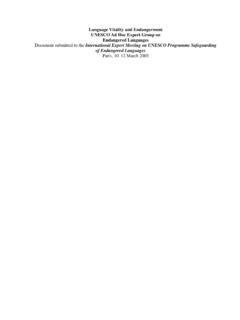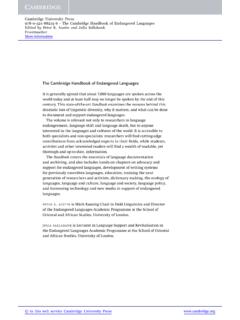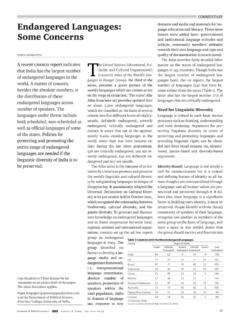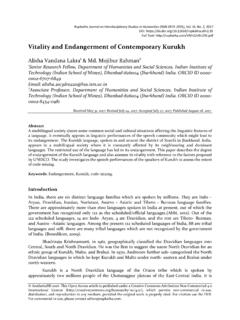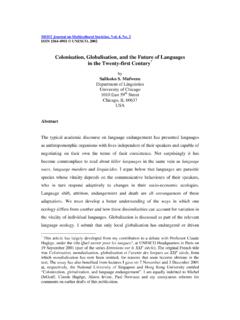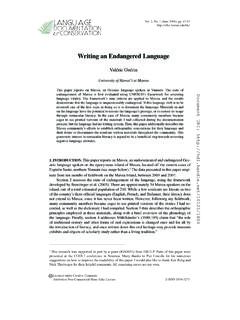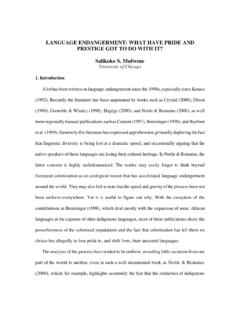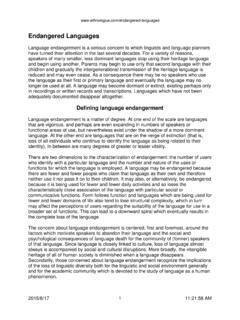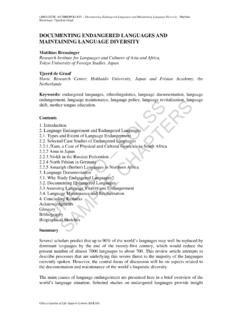Transcription of Saving Languages - The Tlingit Language
1 Saving Languages An Introduction to Language Revitalization Lenore A. Grenoble Dartmouth College, Hanover and Lindsay J. Whaley Dartmouth College, Hanover .. :i .. CAMBRIDGE UNIVERSITY PRESS 1 Language revitalization as a global issue t Introduction Over the past fifty years and with increasing frequency, innovative programs have appeared around the world with the aim of revitalizing Languages that are at risk of disappearing due to declining numbers of native speakers. The nature of these initiatives varies as greatly as the Languages that are their targets. In some instances, they are nearly national in scope, such as the efforts to preserve Irish, yet in other instances they involve small commu nities or even a handful of motivated individuals. Many of these programs are connected to claims of territorial sovereignty, though sult !_: eign y or a desire to maintain a unique ethnic identity is just as often the explicit goal.
2 While in one context a revitalization effort may be centered around formal education, in another it may be focused on creating environ ments in which the Language can be used on a regular basis. Although tremendous variety characterizes the methods of and motives for reinvigorating Languages , revitalization, as a general phenomenon, is growing and has become an issue of global proportion. There are now hundreds of endangered Languages , and there are few regions of the world where one will not find at least nascent attempts at Language revitalization. This comes as little surprise when considered in light of the confluence of several socio-historical factors. First, Language death and moribundity ( the cessation of children learning a Language ) are occurring at an exceptionally rapid rate. While the precise number of Languages in the world is difficult to determine (see Crystal 2000:2-11 for a concise discus sion), and predicting the total number of Languages that will cease to be spoken is harder still (Whaley 2003), there is a general consensus that at least half of the world's 6,000-7,000 Languages will disappear (or be on the verge of disappearing) in the next century.
3 As Crystal (2000: 19) points out, " "To meet that time frame, at least one Language must die, on average, every two weeks or so," a startling fact, to say the least. Whereas the phenomenon of Language death has been present in all epochs, the rate of decline in linguistic diversity is probably unique to 2 Saving Languages our time, perhaps only rivaled by the loss of linguistic diversity believed to have happened during the agricultural revolution 10,000 years ago ( see Maffi 2001). Given this high rate of Language death, we must recognize that a significant proportion of communities in the world today are con fronted with the loss of a Language that has traditionally been an integral feature of their identity. In many such instances, efforts are being made to halt the process of Language shift and to promote the usage of a heritage Language . The sheer number of threatened Languages cannot alone explain the ever-expanding number of Language revitalization initiatives.
4 To this we must add a second major socio-historical shift, the general trend towards recognizing the rights of minorities, both as individuals and as groups, within modern nation-states. Particularly since the end of the Cold War, there has been a collapse of hegemonic patterns in many portions of the world that had actively, and explicitly, worked to suppress cultural differ ence, and as a consequence in many places ethnic groups and minorities have increased flexibility in pursuing their own political agendas (Kymlicka I 995). In a very real sense minority communities have been emboldened to pursue territorial, political, and cultural rights. Though this has meant a burgeoning number of ethnic conflicts (Moynihan 1993), it has also meant rethinking hum n rights at a basic level to include the prote tion of such tbi;g as the choice oflanguag . Consider, as just one -ex ample, Language from Article 5 of UNESCO's Universal Declaration onCultural Diversity, which states: "All persons should therefore be able toexpress themselves and to create and disseminate their work in the lan guage of their choice, and particularly in their mother tongue; all personsshould be entitled to quality education and training that fully respect theircultural identity.
5 " Similar statements can be found in declarations frommany transnational organizations, such as the European Union, theOrganization for American States, and the Organization for AfricanUnity, as well as in recent legislation in a number of countries. Thoughthe effectiveness of these proclamations and laws in ensuring culturalrights is a matter of some debate, there is little doubt that they haveencouraged ethnic communities around the world to pursue activitiesthat assert their cultural identities, and these activities often include pro grams to promote heritage Language less understood factor that has had a role in the increased interest inlanguage revitalization is "globalization." Very broadly defined, globali zation is "a process of increasing international integration of economiclife" (Whaley 2003:969); it is characteristically accompanied by the adop tion of neoliberal political structures, at least to some degree.
6 As theprocess has transformed or eliminated traditional political and economicLanguage revitalization as a global issue _ 3 barriers among nations, there has been a greatly enhanced ability for information, money, people, goods, and services to move between regions. Because of the political and economic might of the United States, it is hardly surprising that mass consumerism and American pop culture have now spread to most regions of the world. Most discussions of globalization have concentrated on the modernizing and assimilatory effects that such forces have on communities, both big and small, as individuals in the communities are brought into the interna tional economic system and are exposed with increasing regularity to Languages of wider communication, the national culture of the state in which they are embedded and non-traditional economic habits. Much less examined is the fact that globalizing forces have triggered reacting forces as some people seek to assert, or better to reassert, their unique cultural identity.
7 More often than not this effort to underscore uniqueness is represented by a "traditionalist" constituency within a community that finds itself interacting with a "modernizing" constituency which advocates greater integration with a regional, national, or international community. A great many Language revitalization programs have emerged as a conse quence of these dynamics. Since Language is a visible and powerful indi cator of group identity, it has accurately been recognized as an important way to maintain links with one's cultural past and to protect one's cultural uniqueness in the present. This picture of broad social, historical, and economic trends that have prompted the appearance of numerous Language revitalization programs is necessarily botn simplified and incomplete, but it provides a general con text for the implicit question underlying all portions of the book: How can Language revitalization efforts be successful?
8 2 Assessing Language vitality >, , - '---\\A \Assessing and understanding Language vitality is a complex enterprise, as a large number of intertwined factors enter into it, yet the degree of Language vitality is the basic indicator used in determining the appropriate type of Language revitalization program. A Language spoken by several thousand individuals on a daily basis presents a much different set of options for revitalization than a Language that has a dozen native speakers who rarely use it. Moreover, assessing changes in Language vitality over time provides the easiest measure of success for attempts to revitalize a threatened Language . As interest among linguists in issues of Language endangerment has increased over the last two decades or so, there have been a number of different studies focusing on how to assess Language vitality . One of the most comprehensive comes from the collaboration of linguists in 4 Saving Languages UNESCO's Ad Hoc Group on Endangered Languages .
9 ' They have worked together to create a document entitled Language vitality and endangerment (UNESCO 2003), which lists nine factors in Language vital ity. The UNESCO Ad Hoc Group is very clear that the nine factors need to be considered in conjunction with one another, a point which we also would like to underscore here. As we discuss in Chapter 2, the particulars of each individual Language situation will mean that some of the factors are more relevant than others. Factor I: Factor 2: Factor 3: Factor 4: Factor 5: Factor 6: Factor 7: Factor 8: Factor 9: Intergenerational Language transmission Absolute number of speakers Proportion of speakers within the total population Trends in existing Language domains Response to new domains and media Materials for Language education and literacy Governmental and institutional Language policies, including official status and use Community members' attitudes toward their own Language Amount and quality of documentation As is clear from this list, the first three factors have to do with the numbers of speakers of a Language , as well as their distribution across generations and throughout the population.
10 Factors 4-7 identify how and where the Language is used. Factor 8 addresses perceptions about the value of a Language by its speakers. Factor 9 identifies the material that has been produced about a Language . Even under quick review, it becomes clear why one cannot separate the influences of these factors from one another. For example, the use of the Language in both new and existing domains (Factors 4 and 5) is very much dependent upon community attitudes, as well as governmental policies. Factor 9 is somewhat of an oddity in this list since the existence of Language documentation is not an evaluating factor per se in assessing Language vitality ; reasonably good documentation exists for some Languages that are extinct, whereas there is poor documentation for highly vital Languages . Rather, the level of vitality helps in assessing the urgency for new Language 1 The document was vetted and refined in a working symposium held in Kyoto, Japan in November 2002.
